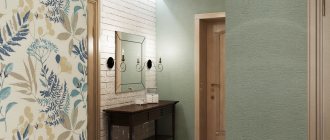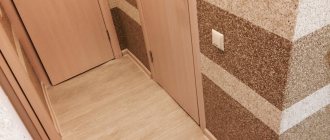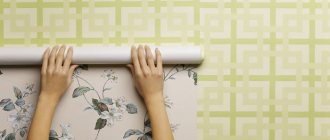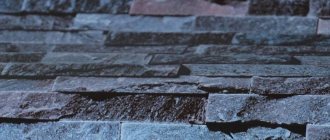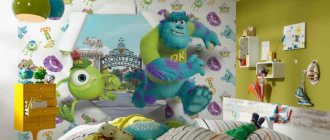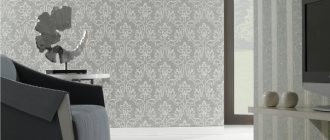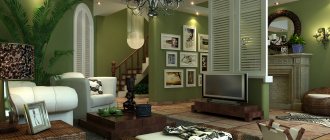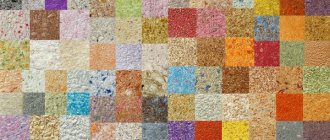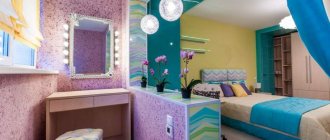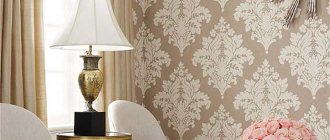The issue of comfort and silence in the apartment has always been very acute. Today, a significant number of different ways to reduce noise levels are known, but most of them require serious financial investments. However, there are also auxiliary options that can solve this problem at a fairly attractive cost. Soundproofing wallpaper successfully helps combat sound intensity.
Of course, they cannot guarantee 100% insulation, but they are quite capable of reducing the level of incoming and outgoing noise.
Advantages and disadvantages
All of the above wallpaper options have high soundproofing characteristics, but in addition to this there are other qualities:
- Ecological cleanliness. All products are made from high-quality materials that do not harm the human body and health. As for cork, it is made from natural ingredients.
- Possibility of use in rooms with high humidity. If we talk about cork and velor models, they are not considered universal coverings, especially with humid air, but taffeta and vinyl products can be used in absolutely any room, from the bathroom to the bedroom.
- Variety of designs and patterns. If cork products do not have a colorful design, then other options can be selected according to various preferences and parameters. As a rule, cork canvases are a rational solution for decorating an office, study or library.
- High strength. Vinyl sheets can boast of increased material strength. Other types of products are less durable, which means they will have to be glued and re-glued more often. The service life of vinyl sheeting is at least ten years, which is an order of magnitude longer than that of other rolls.
- Easy to stick. Almost all types of wallpaper can be dealt with without unnecessary difficulties. The only material that can cause inconvenience is cork. It is better to invite a specialist to paste such paintings. After all, the technology and the materials themselves differ from the traditional ones used in conventional wallpapering.
- Price. If we consider the price range, then non-woven and paper-based vinyl products are considered the cheapest. The rest are quite expensive, so if you have the budget, you can take it, and if not, then you can glue vinyl ones as an alternative.
The range of wallpaper on the modern construction market allows you to choose exactly what suits you and your wallet. Soundproofing wallpaper will help create optimal conditions in the room, even without extensive sound insulation.
Stages of pasting a room
If you decide to paste the wallpaper yourself, then you should begin such work by pasting the walls that are located near the door or window. We should not forget that the room must be draft-free.
To do this, windows and doors must be closed. Otherwise, the soundproof wallpaper may peel off easily.
As for the optimal temperature, it should be at least 180 degrees. The humidity in the room is recommended in the range from 60 to 70% (no more than this value).
When preparing a room for wallpapering, you should also measure the walls. Their humidity should not be more than 4%. In order for this indicator to be normal, it is necessary to treat the surface of the walls with a primer mixture.
When gluing soundproofing wallpaper, it is best to apply the adhesive directly to the wall. After this, simply apply the cloth and smooth it with a dry cloth. Such manipulations will help release all the air under the wallpaper.
This means that bubbles will not form on them. If they do appear, they need to be carefully pierced with a needle and again carefully wiped with a dry cloth. The surface must be smoothed from the center to the edges of the canvas.
When gluing walls with such materials with soundproofing properties, you should definitely pay special attention to their joints. It is not recommended to apply the edges of the canvases to each other using the “overlapping” method.
It is best to spread the composition on the walls and let it absorb a little (it can also be applied to the sheets themselves). After this, until the composition on the surface has dried, the canvases can be glued.
As for cork coverings, it is best to entrust the installation of such wallpaper to a professional. All the rules listed here apply to wall decoration with vinyl, tufting and velor finishing materials.
An overlapping joint is well suited for gluing corners. This method is recommended by design experts because it can virtually minimize the possibility of wrinkling or loose sheets.
If vinyl wallpaper based on non-woven material was used, then a situation may arise when the borders do not stick to their surface. In this case, it is best to attach them directly to the wall surface. Despite the fact that this process is quite labor-intensive, it is much more reliable.
In those areas where there will be space on the wallpaper for a round rosette, you should cut out a circle. Inexperienced home craftsmen most often do not know how to do it. The simplest option would be to cut a sheet of wallpaper in the shape of a cross. Next, after each sector a circle should be formed.
Repair experts advise not to delay decorating the room with soundproofing sheets. It is best to spend no more than a day on each room.
Proper pasting of corners
Wallpapering a corner
To glue the outer corners, you need to proceed as follows: cut the wallpaper, which will be 3 cm larger than the previous sheet, to the corner.
After this, the strip is sealed.
In this case, the corner should bend in the opposite direction.
If the corners are right, then the remaining part must be glued end-to-end.
If not, then the wallpaper is glued in an “overlapping” manner along the markings that run in the vertical direction.
After this, you need to trim the remaining edges, pressing them well. The best way to do this is with a ruler.
You can simply stick soundproofing wallpaper end to end. This is most often done with vinyl wallpaper based on non-woven fabric.
If you need to glue the internal corners, then before starting work you should measure the distance that goes from the last sheet to the corner. In addition, you need to add 3 cm.
After this, you should cut a strip of the desired size and glue it to part of the wall and corner. To ensure that the coating “grabs” well, you can run it with the blunt side of a knife.
To glue thick wallpaper with noise-absorbing properties (especially for cork coverings), you should use a plumb line with an overlap that goes to the adjacent section of the wall.
After this, you need to attach a ruler to the wallpaper and run a knife along it, cutting off the excess parts of the canvas. In this case, you need to press the edges of the sheet well on the wall. Only in this case the joints will not be visible.
Installation
Installation technologies for modern soundproofing materials vary depending on the material chosen.
Using dowel nails
Such a system is used in such materials as Phonestar GW. The panels are fastened using special dowel-nails, which are inserted into the designated holes in the panels. You need to drill holes in the wall in advance to connect it and the panels.
Installation should begin from left to right and from bottom to top. Before installing the outer panel, its outer edges are cut off. The starting bar is installed close to the wall.
Applying plaster
Installing acoustic plaster yourself can cause many problems, as it requires certain skills. Beacons are pre-installed, which allow you to create a flat surface.
The plaster application process consists of three stages. The first step involves spraying a thick mixture as a base. The second stage involves filling the voids. The third is needed to consolidate the result.
Adhesive base
Such materials produced by SOFTBOARD are applied to a specially prepared adhesive base. Liquid nails intended for this purpose can be used as glue. Liquid nails are applied along the edges and in a couple of places in the center. First, the surface of the base is leveled using plaster.
The process of installing soundproofing material under wallpaper should not cause much difficulty, especially if you have certain skills. In order to get an excellent result at the end of the repair, you must fully comply with the installation technology:
- Preparing the wall surface. First you need to prepare the work surface where the material will be glued. To do this, it is necessary to eliminate defects in the form of large cracks. This is done using plaster, which is applied with a spatula; the surface is first primed. There should be no previous material left on the wall.
- Cutting strips. Soundproofing underlay for walls is sold in rolls over 10 meters long. Before gluing, it must be divided into strips equal to the height of the room. If possible, this should be done with a small margin, especially in the absence of practical skills, so that there is room for maneuver.
- Applying glue. Depending on the material used, the adhesive is applied to various surfaces; when using a non-woven backing, the adhesive is applied exclusively to the walls; polyurethane material requires additional application to the backing itself.
- Gluing strips. After applying the glue, you can proceed to gluing the strips. This must be done carefully to ensure neat joints. They should not stick out or puff up. Additionally, you can apply paper tape to the joints to obtain a better result.
- Drying. After completing the work, you need to let the glue dry. It is prohibited to perform any manipulations with the substrate within 72 hours. Only after the expiration of the period can the finishing work begin.
Modern soundproofing materials make a person’s life much more comfortable, eliminating extraneous noise, which can cause significant harm to his health. However, installation of the material also has its drawbacks, but they are compensated by a large number of positive aspects. It is up to everyone to decide whether to use it or not.
In the video you will see the process of sound and noise insulation of walls, and will also tell you what materials are needed and their cost.
Life in modern cities is becoming more and more stressful. The noise does not subside either day or night. The rhythm of people’s lives also changes, and at the hour when many are preparing to rest, some are just entering the active stage of wakefulness. All this creates additional noise pollution, which must be reduced in order to ensure comfort and peace for yourself and your loved ones. Modern sound-absorbing wallpaper can help with this.
Carpet wallpaper gluing technology
It is very important to comply with the conditions for gluing wallpaper, since the service life, as well as the preservation of the qualities of the material, will depend on this.
First of all, it is necessary to level the surface of the walls. For this you can use plaster or putty. After the wall has dried, it will need to be sanded with sandpaper.
The next step is applying the primer. Since carpet wallpaper is a heavy type of material, it is necessary to increase the adhesive ability of the wall surface. You can use wallpaper glue or a special primer. After this treatment, the wall should dry well.
After preparing the base, you should measure the height of the walls and cut off the required amount of canvas from the roll, but be sure to add a small margin.
Then you need to apply glue to the walls. There is no need to apply it to the wallpaper base. Strips of wallpaper are rolled out on the wall using a soft roller or piece of fabric. The next strip is glued end to end.
Soundproofing walls features
Installing sound insulation under wallpaper will not be difficult if you delve into some of the subtleties. There is a difference between sound absorption and sound insulation. Absorption occurs if the noise comes from outside, and insulation occurs when the sounds of an apartment or house do not extend beyond the walls. Sound insulation features:
- comfort - external sounds do not reach the apartment residents;
- there is sound insulation that has a surface that does not require a finishing coating;
- it is possible to play loud music or talk until late in the evening;
- They not only have soundproofing properties, but also provide thermal insulation.
Despite a number of features, there are disadvantages. Installation of some materials requires free space. The second drawback is the significant price, but it is justified by the above properties.
If the apartment or house is small in size, there is sound-absorbing wallpaper on the construction market, as well as a lining for the coating.
Advantages and disadvantages
Now you know general information about each type of sound-absorbing wallpaper, but let’s summarize by describing their main advantages and disadvantages.
Features of tufting
- high sound insulation performance;
- good thermal insulation qualities;
- external attractiveness of the material;
- do not require special personal care;
- they do not contain substances hazardous to human health;
- do not deteriorate after contact with moisture;
- easy to glue;
- resists UV exposure well;
- with their help you can hide minor imperfections in the wall;
- have high strength.
How to soundproof walls under wallpaper
- due to their artificial origin, they accumulate electrostatic charges and also collect dust;
- people suffering from chronic asthma may experience attacks due to dust accumulated in the lint;
- it is necessary to carry out wet cleaning frequently;
- weakly resist mechanical stress;
- their price is quite high.
Features of artificial velor
Advantages of wall covering:
- is an electrostatic storage device;
- the surface gets dirty quickly and therefore needs frequent cleaning;
- short service life (less than 5 years);
- poor resistance to moisture;
- serious vulnerability of the decorative layer to mechanical stress.
Mineral boards - soundproofing materials for walls under wallpaper
Features of cork wallpaper
- made from natural material, which is harmless to humans and environmentally friendly;
- shows good sound insulation qualities;
- due to the absence of harmful impurities, they can be used even in medical institutions;
- tolerate moisture well;
- can withstand mechanical stress during operation;
- have good adhesion;
- due to its versatility, it can be used to decorate any room style;
- do not attract dust, which makes them easy to clean. You can even use wet wipes to clean up dirt.
Elastic Cork Insulation Wallpaper
- the cost of such wallpaper is much higher than the cost of competitors;
- In order for them to be glued to the wall, it is necessary to first make its surface perfectly flat, because... As a result of the fine structure, any defects will be clearly visible. The problem can be solved by using cork slabs, which are much thicker;
- long and complex installation process. The instructions require serious attention during gluing, so everything must be done very carefully so as not to spoil the appearance.
At the same time, no unnecessary noise from the street or neighbors will enter your room, so nothing will interfere with your relaxation. If the noise loads are quite serious, as an alternative, you can use a roll covering or cork slabs, which will further enhance the sound insulation performance.
What to consider when choosing a material?
All modern materials have different properties and are used in certain conditions. In order to choose the right material, you need to know and understand the features of the room where you plan to finish it with soundproofing material.
Noises are divided into:
- Airborne noise. Occurs by spreading through the air, for example, people screaming, music playing or a car alarm going off.
- Impact noise. Sounds passing through walls and ceilings originate from mechanical influence. It is also called structural noise, associated with the movement of furniture, drilling or movement of liquid through sewer pipes, falling of heavy objects, and the clicking of heels.
Materials can be:
- Sound-absorbing. Designed to absorb all noise inside the structure. They have a granular or fibrous structure. Light weight and low cost greatly facilitate the installation of this group of materials.
- Soundproof. On the contrary, they do not allow sounds, reflecting them at the entrance. The best way to solve the problem of noise penetration from the street. They have a large mass and dimensions, and are quite difficult to install on your own.
When choosing a soundproofing material, it is important to pay attention to the environmental component, especially if it will be used in children's rooms or among the elderly.
Advice! When calculating the cost of sound insulation, take into account not only the material, but also the components for its fastening or installation (lathing, fasteners, glue, etc.). As a result, the cheapest one may turn out to be more expensive.
Which material is the thinnest?
With the use of thin soundproofing materials it is possible to achieve good results
Today the market offers a huge selection of materials that can be selected according to characteristics and preferences. If you choose the thinnest sound insulation, then you should pay attention to propylene foam products, which, despite their thin base, provide a high degree of efficiency. Among the previously described materials, Tecsound, whose thickness is only 3.7 millimeters, ideally suits this criterion
If you use the canvas in combination with other bases, it is possible to completely eliminate sounds in the house.
Soundproofing
Knowing this problem, engineers are trying in every possible way to increase the sound insulation of a living space by producing specialized building materials. First of all, they developed double-glazed windows that allow windows to be tightly closed, eliminating unnecessary noise on the streets.
But what if the noise comes from inside the house, for example from neighbors. For this purpose, wallpaper experts have developed special, noise-proof wallpaper. Of course, soundproofing wallpaper is not a panacea for all annoying sounds, but if you use it comprehensively, together with good double-glazed windows, special materials for the floor and ceiling, you can achieve good results.
Only an integrated approach to combating sound produces results.
Installing soundproofing wallpaper will be the first, confident step towards achieving a calmer and quieter atmosphere in your home. Let's look at the main types of such material.
Advantages of soundproofing wall finishing
The process of installing sound insulation in your own apartment will not take much time and effort. First, there are some important things you should know, including the difference between sound insulation and sound absorption. In the first case, noise does not penetrate from adjacent apartments, while in the second, sounds from your room will no longer reach the ears of your neighbors.
Soundproofing under wallpaper can please residents with the following positive qualities and advantages:
- Increased level of comfort - conversations of neighbors, loud music and all other extraneous noise will be eliminated.
- Some finishing materials have a remarkable appearance and decorative properties, which allows them to be used as a finishing coating without the need to glue vinyl wallpaper.
- It becomes possible to make noise yourself, within reason, without causing inconvenience to people in adjacent rooms.
- Modern materials provide not only noise protection, but also excellent thermal insulation characteristics.
The only serious drawback is that the usable living area is reduced. This point is especially important for owners of small apartments, where every centimeter plays a big role. In this case, it is recommended to choose frameless finishing options, as well as use thin membranes and sound-absorbing wallpaper.
Soundproof wallpaper: selection criteria
Currently, sound insulation of walls, ceilings and floors in apartment buildings is considered quite common. There are a lot of different building materials, thanks to which you can achieve the optimal effect.
@Oboi
Of course, to completely soundproof a room, you need to do everything from scratch, which takes a significant toll on your pocket and budget. Many people who rent their homes are reluctant to do a complete top-notch renovation because they could be kicked out of their rental property at any time. In order to make high-quality soundproofing of an apartment and at the same time not be expensive, you need to use appropriate materials. If you are planning a cosmetic renovation, then as an option you can take sound-absorbing wallpaper, which will not only add beauty to the house, but also provide a certain soundproofing effect.
Advice! There is no longer a need to completely destroy the apartment if soundproofing is needed. All you need to do is select the wallpaper and backing, which results in effective and reliable protection against sound.
Sound insulation materials
There are several types, divided into performing specific functions.
Sound insulation – reflection of incoming noise. The sound insulation of a wall is determined by its thickness. The thicker the structure, the better the sound insulation. Noise insulation index 52-60 dB. Additional soundproofing materials include plasterboard.
Noise absorption - absorption of noise by the material used, which has a structure of fibers, with the addition of crumbs, looks like cells. Sound absorption coefficient 0-1. Average value 0.4.
Soundproofing materials include films and membranes. They are thin and at the same time have a good coefficient. The mineral membrane has a thickness of 0.25-0.37 cm. It is aragonite - Texound, barite - vinyl.
Polyethylene has a thickness of 0.5 cm. It is mounted under the wallpaper. As well as lead foil having a thickness of 0.7 cm.
The most applicable materials are divided into types.
Soundproofing panel ZIPS, used in rooms under wallpaper to achieve silence in the apartment. This is a sandwich panel consisting of mineral wool and plasterboard. Depending on the type, the panel thickness varies from 40-130 mm. Drywall is used with a thickness of 12.5 mm. Installation is carried out using a vibration-isolating gasket. The connection to each other is made using a tongue and groove. The noise insulation index increases by 9-18 dB (depending on the thickness of the ZIPS).
Fiberglass
Vibroacoustic sealant
High vibration insulation of joints in the mounted structure (from gypsum plasterboard), as well as reduction of structural noise. The seams of the created structure under the wallpaper are filled with sealant. When using, protect eyes and skin from contact. Once dry, it is non-hazardous and non-toxic.
Isoplast
The material is made from coniferous trees. It does not allow noise from the outside to penetrate, while at the same time it has thermal insulation properties. It is used both under wallpaper and putty. Environmentally friendly material. Easy to install. Its disadvantage is considered to be high cost.
Noise reduction up to 27DB.
Soundproof wallpaper
The lining for the wallpaper is made of foamed polyethylene covered with paper. This is a roll-type sound-absorbing material. It has the property of insulation, as well as the following features:
- health safety – the material is created from elements that are not harmful to human health;
- prevents the spread of mold, does not rot;
- installation of roll material does not reduce useful square meters;
- service life is 50 years.
There is another advantage - leveling the walls before wallpapering.
Disadvantages - high cost. And also if the room is damp, the accumulated condensation will collect as water droplets on the wallpaper.
The backing for the wallpaper is made of cork or non-woven fabric.
Soundproofing membrane
Rolled material of mineral composition. Installation is carried out using glue to a different surface. Noise reduction occurs up to 22 dB. The membrane has a number of features:
- does not tear;
- harmless to health;
- service life up to 20 years;
- at a temperature of -20 0C it does not burst.
Soundproofing putty
The soundproofing mixture contains granules that reflect sounds. It is applied in a thin layer to reduce noise coming from the room, as well as improve acoustics.
For the best effect, the mixture is applied in a layer of 20 mm.
The disadvantage of the mixture is that it does not suppress strong sounds. Sometimes the putty is applied in 2 layers.
Shumozol
This is a roll material created on a bitumen basis. It is thin with good noise-absorbing properties. Mounted with adhesive under drywall and putty. Has the following properties:
- impact noise removal up to 27 dB;
- has waterproofing properties;
- flexible;
- not hazardous to health.
The downside is the high cost.
Cork
Cork materials are divided into groups that have their own functions.
- A pressed sheet created from crumbs. Does not rot. Has a service life of 40 years. Prevents the spread of mold. Sheet thickness 2-4 mm. Can be produced in rolls. Impact noise reduction index 12 dB.
- Substrate. It is created by mixing cork granules and synthetic rubber. Reduces impact noise. Used as a substrate for various finishing materials. To install the substrate, waterproofing is required.
- The base is kraft paper, bitumen impregnation, cork crumbs. Waterproofing is not required during installation. But, with strong moisture, the crumb peels off from the base and begins to rot.
Cork sound insulators have positive properties and some disadvantages - they do not tolerate high moisture, and are also expensive.
Zvkukoizol
This is a seven-layer material created from sheets of cardboard and a mixture of quartz sand. The panel has a thickness of 1.3 cm. The noise absorption index is 38 dB. Mount the panels with glue.
There is also soundproofing in rolls. This is foamed polyethylene foam and bitumen. It is a waterproofing agent. Elastic, durable.
Types of modern materials for wallpaper
There are several main types of modern materials that are used to soundproof walls under wallpaper. Each choice depends on many factors and indoor conditions.
| № | Material | Impact noise absorption, dB | Airborne noise absorption, dB | Price per sq.m. |
| 1 | Soundproofing membrane Soundguard 2.0 | 22 | 27 | from 545 rub. |
| 2 | MaxForte | |||
| ShumoIzol | 27 | 55 | from 290 rub. | |
| SoundPRO | 34 | 65 | from 1090 rub. | |
| ECOpanel | 33 | 48 | from 1050 rub. | |
| 3 | TechnoNIKOL | |||
| Acoustic Super A350 | 28 | 27 | from 256 rub. | |
| Acoustic S B350 | 23 | 23 | from 263 rub. | |
| 4 | ZvukoIzol VEM | 26-28 | 4-6 | from 540 rub. |
| 5 | SoundIsol | 26 | — | from 187 rub. |
| 6 | Tecsound | 22 | 28 | from 1429 rub. |
| 7 | Isoplast | 28 | 23 | from 690 rub. |
| 8 | Soundproofing plaster | until 23 | up to 60 | from 14 rub/kg |
| 9 | ZIPS | |||
| Vector | 32 | 18-20 | from 1983 rub. | |
| Module | 32 | 12-20 | from 2041 rub. | |
| System | 32 | 10-24 | from 1712 rub. | |
| 10 | Softboard | 20 | 35 | from 200 rub |
| 12 | PhoneStar | |||
| Triplex | 33 | 36 | from 990 rub. | |
| Soundproofing membrane PS 4 | 28 | 28 | from 1050 rub. | |
| G.W. | 34 | 16-17 | from 990 rub. | |
Soundproofing membrane SoundGuard 2.0
Has good soundproofing properties. The composition includes minerals, as well as polymer binder particles. Available in rolls. Suitable for mounting various surfaces: walls, ceilings, floors.
Among the advantages of this material are:
- resistance to temperature changes;
- resistance to mechanical stress;
- well suited for rooms with damp environments.
MaxForte
A domestic company that produces modern soundproofing materials in close cooperation with laboratories of Moscow State University, NIIMStroy, etc. It produces a wide range of products for reducing noise under wallpaper:
- ShumoIzol. Has high flexibility and elasticity. Resistant to various types of mechanical damage. It is made of non-woven two-layer material: polyester and bitumen. Available in roll form. Not afraid of low temperatures. Installation must be done exactly butt-to-edge using mounting tape.
- SoundPRO. New generation material obtained as a result of taking into account the experience of practical work and theoretical developments. It has a small thickness of 12 mm, however, it effectively copes with its task. The base uses non-flammable material, perfect for kindergartens and schools. The base uses aluminosilicate fibers. It retains heat perfectly.
- ECOpanel. Multilayer material with a complex structure, filled inside with quartz sand. Large weight also helps to absorb vibration waves and prevents the occurrence of resonance phenomena. The installation technology is in many ways similar to attaching drywall sheets.
TechnoNikol
There are two types:
- Acoustic Super A350 . Soundproofing material effectively protects against impact noise. Has good waterproofing properties. The basis of the material is fiberglass, onto which a protective material consisting of a bitumen-mineral binder is applied.
- Acoustic S B350 . Material that does not have a base. It consists of a metallized polyester film coated with a special thermal bonding material made of bitumen material.
SoundIsol
Modern material with wide application. Can be used in rooms of various types. Has a high level of waterproofing.
- ZvukoIzol VEM. This is a soundproofing membrane that is made of polymer materials. It has a high level of elasticity and a long service life.
- SoundIsol. An environmentally friendly material that does not emit a smell, thanks to this it can be used in kindergartens, schools, and hospitals.
Tecsound
Material produced by the Spanish company Texsa. It has a small thickness of 3.7 mm, however, it can significantly reduce the noise level to 28 dB. Can be used in conjunction with other soundproofing materials. It withstands significant temperature changes with minimal deformation. Absolutely non-toxic, can be used in the interior of any premises.
Isoplast
Durable modern material produced in rolls. Resistant to tearing. Outwardly, it is similar to roofing felt, however, it surpasses it in many respects. A protective film is applied on both sides and covered with a thin layer of bitumen with the addition of a polymer material.
The advantages of this material include:
- resistance to mechanical damage;
- resistance to bacteria;
- environmentally friendly composition;
- light weight;
- good sound insulation;
- long service life.
The cost of a square of material is 1050 rubles.
Soundproofing plaster
This material is also called acoustic plaster. Which contains particles of expanded clay, pumice and other elements that reduce noise levels. The composition applied to the wall is light and reliable.
The advantages over other materials include universal use even on surfaces with complex terrain. However, it is worth paying attention to the complex application procedure, which not every person can cope with. Well, the work of applying plaster lasts more than one day.
ZIPS panels
The panels from this manufacturer are mounted on the wall using special vibration units and do not require installation structures for installation.
- ZIPS Vector . This system is designed for installation on finished walls. It consists of a combination of sandwich panel and plasterboard. The panels are equipped with tongue-and-groove locks, greatly facilitating installation. It is used for sound insulation under wallpaper, effectively coping with loud noises.
- ZIPS Module . The internal insulating material consists of a plasterboard base, onto which basalt material is glued in several layers.
- ZIPS System . The most effective of the ZIPS. Designed to have the opposite effect, preventing noise from penetrating from the room to the outside. It has a similar structure to the Module system, however, the mineral layer is much thicker and reaches 110 mm.
Softboard
Natural soundproofing material of domestic production copes well with soundproofing premises for various purposes.
The advantages of this material include:
- no shrinkage under significant temperature changes;
- resistant to mechanical stress.
This material can “steal” a large area of usable living space.
PhoneStar (FonStar)
- PhoneStar Triplex. The panel system for sound insulation consists of minerals of organic origin. The thickness of the plate is 12 mm.
The advantages include:
- environmentally friendly composition;
- saving usable space;
- light weight.
- PhoneStar GW . System of vibration-decoupled layers. They differ from each other in composition and density. It can be used for soundproofing work in various rooms. Has the same advantages as the previous material.
- Soundproofing membrane PS 4. Soundproofing material with a polymer base, 4 mm thick. It can be used for soundproofing residential and non-residential premises for various purposes.
The main advantages of this material include:
- maintaining plasticity under significant temperature changes;
- resistance to mechanical stress.
Pros and cons of various sound-absorbing wallpapers
Now that the main types of sound-absorbing wallpaper are presented, it will be useful to clearly outline the advantages and disadvantages of each type.
Tufting wallpaper
Pros:
- Good sound insulation
- Additional thermal insulation
- Beautiful appearance, which is ensured by a large designer variety of colors and types of finishes of such wallpapers
- Ease of care
- Safety for humans - non-toxic, biologically inert, does not contain hazardous compounds
- Moisture resistant, tolerates contact with water well, dries quickly
- Simple and easy to install
- Do not fade, are not affected by UV rays
- Well hides minor imperfections of the base surface
- Have high tensile strength
Minuses:
- Accumulate electrostatic charge and attract dust
- Dust accumulates between the villi and can trigger an asthma attack in chronic patients with this disease.
- Requires frequent maintenance to remove accumulated dust
- Poorly tolerate mechanical stress
- Have a relatively high cost
Tufted wallpaper is a good solution for residential premises and public enterprises. They not only insulate rooms from excessive noise, but also insulate well, so it makes sense to use them on cold external walls, soundproof and at the same time insulate joints.
Faux velor wallpaper
pros
- Attractive appearance
- Average degree of sound insulation
- Wallpaper does not fade in the sun and near the central heating radiator
- Average price category, velor wallpapers are cheaper than tufting or cork
- Quick and easy to apply
- Can be cleaned using a soft brush of a vacuum cleaner
Minuses
- Just like tufting, they accumulate electrostatics due to their artificial origin. The consequence is rapid contamination of the coating.
- Relatively low durability. The service life rarely exceeds 5 years.
- Does not tolerate moisture and water
- Practically, they do not resist mechanical stress, the decorative layer is very vulnerable
Artificial velor wallpaper is most suitable for the apartment of a single person, without pets, or for decorating a quiet office with few employees. Then this type of coating will be able to reduce the level of external noise, and not be subjected to serious operational loads for which it is simply not intended.
Cork wallpaper
pros
- Natural, natural material, environmentally friendly and safe
- Provide a high level of sound insulation
- Provide natural ventilation of the room
- Absolutely safe for humans, can be used in children's and medical institutions, and is also suitable for people with health problems.
- Moisture resistant
- They are durable and resistant to operating loads
- Have good adhesion to almost any surface
- They are highly combinatorial and can be integrated into almost any interior style
- They are easy to care for with a simple soft brush, since cork wallpaper does not accumulate static and does not attract dust. If contamination occurs, it can be removed with a damp cloth and a non-aggressive care product.
Minuses
- High price
- Cork wallpaper requires a flat surface, since due to its thin structure, unevenness on the wall will be clearly visible. Cork slabs are not so capricious; their thickness allows you to effectively hide minor imperfections in the finishing of the base wall.
- Cork wallpaper must be glued as carefully as possible, since negligence or carelessness will be clearly visible on a flat wall. Therefore, if you are not confident in your abilities, it is better to invite specially trained craftsmen.
Cork wallpaper is a universal means of soundproofing rooms for any purpose. They are suitable for both the external wall of a panel house and interior walls. They will save you from the sounds of the city street or from too noisy neighbors. If the noise level is very high, cork wallpaper can be replaced with cork tiles or roll covering. Then the sound insulation result will be even more impressive.
Quality criteria
Suppose you decide to use noise-reducing wallpaper from our list, what pleasant and unpleasant moments await us.
Wallpaper with interesting monograms in a large room
- An increased level of noise suppression and sound insulation are inherent in all of the above types of canvases.
- Completely natural material, absence of harmful substances. Cork wallpaper is completely natural, but the other options are all artificial, but not one of the types of soundproofing wallpaper causes harm to humans.
- Moisture resistant. We can note this quality in vinyl and taffeta, but vinyl and velor are very afraid of water and quickly become ugly from it.
- Versatile in terms of colors and patterns. Here, the only thing that has a bad reputation is cork, which has limited variability, but other types of canvas have a wide range.
- Increased strength characteristics. Only vinyl can boast of great strength; all other types of wallpaper: cork, velor, taffeta do not have outstanding strength properties.
- Easy to install. Cork is the most difficult thing to install on walls; the process must be taken very seriously. It is best to entrust the work of gluing cork wallpaper on the wall to professionals. You can handle other types of wallpaper yourself.
- Price. The price for all these types of finishing materials is decent, since the production process of each type of wallpaper is complex and multi-level.
Wide selection of vinyl wallpaper for walls
The use of soundproofing wallpaper together with other similar materials will create a cozy and quiet interior in which you will be happy and more likely to relax. However, it is worth remembering that wallpaper alone will not cope with this task.
On the other hand, such wallpaper can become an unusual interior solution that will make your room stand out from the crowd of others. Use modern, technologically advanced noise-reducing wallpaper in a tasteful manner, then it will not only help you solve noise problems, but will also decorate the room.
Pasting process
The backing is very easy to use, so you won’t have to work hard with it while working. You only need to do the following:
- Completely clear the wall of wallpaper or other material.
- Large cracks and crevices are smoothed out by covering with plaster.
- The wall must be leveled so that there are no large differences due to unevenness. If such a need arises, the wall should be re-primed.
- The wall must be clean and dry.
- The roll of backing is cut into sheets of the length required for gluing. It is worth remembering that for non-woven wallpaper, you buy a special glue for non-woven wallpaper, which is applied only to the wall. For polyethylene foam and cork, glue must be applied to the substrate and the wall. After spreading the glue, wait 3 to 5 minutes for it to dry slightly. This will make it easier to place sheets of material in the desired place on the wall.
- The backing strips must be glued joint to joint, and then the seams must be reinforced with paper tape.
It is better to wait a few days until the wallpaper backing is completely dry. To ensure that the wallpapering of the room does not suffer from the poor quality of the work performed, it is not recommended to carry out work at high temperatures. The ideal temperature is +10, so repairs should be done either in spring or autumn. There should be no drafts in the room where they plan to work with the wallpaper backing.
Life in a large city is accompanied by constant noise coming from outside the windows, and it does not subside either day or night. Changes are also taking place in the rhythm of people’s lives - when some are already getting ready for bed, others are just starting to work. One solution to this problem is to purchase modern wallpaper with a sound absorption function.
In the photo - soundproofing wallpaper for the living room
When purchasing such material, it is worth remembering that it will only help to slightly reduce the noise entering the room from the outside world. If you are faced with the task of achieving complete soundproofing of the room, you won’t be able to get away with wallpaper alone. It will also be necessary to treat the ceiling and floor, as well as take care of good windows, which will also reduce noise effects.
However, we are not talking about this now. Let's try to understand the main types of sound-absorbing wallpaper, which are most often divided by the material from which they were made.
Soundproofing walls with wallpaper is a way to get a healthy sleep
Types, properties and characteristics of soundproof wallpaper
Structurally sound-absorbing wallpaper for walls is a three-layer material. The first and third layers are more dense compared to conventional fabrics. The middle one is made of porous material, which acts as a barrier to sound penetration.
The thickness of the coating also has a function in reducing noise intensity. In addition to three-layer wallpapers, there are also two-layer soundproofing wallpapers.
Wallpaper with a noise-absorbing effect is available in several variations:
- Tufted (carpet),
- Velor,
- Cork.
Tufting wallpaper
This is a two-layer material consisting of a fabric base and a decorative pile part made of synthetic fibers. The density of the material allows it to recreate a regular carpet.
It is thanks to the excellent density that the room is insulated. To achieve the best effect, you need to cover all the walls in the room with tufted wallpaper.
Along with the noise-absorbing effect, carpet wallpaper can well insulate the space, which is important for “cold” walls. A special feature of wallpaper is its vapor permeability, which prevents it from causing fungal growth. Once wet, tufted wallpaper dries very quickly.
Caring for them is quite simple. Cleaning can be done either with a vacuum cleaner or with a damp cloth using carpet cleaners. Working with wall coverings should also not cause any difficulties.
The main thing is to avoid getting excess adhesive on the front surface. In addition, the material will help hide minor flaws in the base.
The disadvantages of the coating are carpet soundproof wallpaper, the average price of which is 2,500 rubles. per roll, do not have antistatic properties, which requires frequent cleaning.
Sound-absorbing wallpaper made of synthetic velor
Visually imitate velvet fabric. They consist of two layers: the main one is made of thick paper, and the decorative one is made of polyvinyl chloride fibers. Of course, the noise-absorbing characteristics are low compared to even a layer of drywall. But to combat noisy neighbors, the coating is quite suitable.
Synthetic fibers can be supplemented with natural ones, in particular jute or sisal. The combination of piles of different lengths allows you to create good acoustics in the room.
Velor soundproofing wallpaper for walls has a wide variety of patterns, shades, textures and shapes. They are easy to work with.
There are also disadvantages - low strength combined with poor moisture and wear resistance. Therefore, it is better not to use them for finishing kitchens, dining rooms, corridors, bathrooms and other wet areas.
Also, the price is quite high - from 4,000 to 15,000 rubles. per roll. This type of wallpaper is not very effective as a noise-absorbing wallpaper, but you cannot deny its decorativeness and beauty.
Cork wallpaper with noise-absorbing effect
The most optimal way to reduce noise levels. They include two layers: the main one - made of compacted paper or non-woven fabric, and the decorative one - in the form of veneer made from cork oak bark.
In addition, cork can also be presented in the form of slabs made without a paper base. The function of the base is performed by compressed cork chips, that is, the coating consists of two layers of cork.
The main advantage is the ability to absorb the intensity of incoming and outgoing noise by more than 70%. Indeed, sound-absorbing cork wallpaper is an excellent heat and sound insulation barrier with an unusually attractive natural decorative surface.
Impeccable sound insulation is achieved due to air-filled dense cells that prevent the penetration of sound waves. The natural composition can be used for finishing any premises.
The natural adhesive (resin) released by wallpaper has a disinfecting effect. Vapor permeability is the key to a continuous process of natural ventilation. This creates a pleasant microclimate and minimizes the risk of mold spreading from frequent condensation.
Soundproof cork wallpaper, the average price of which is 1000 rubles. per m2, they also have several disadvantages. The main one is the need to carry out thorough preparatory work with the base in order to bring it to ideal condition.
The pasting process is not simple and can cause some difficulties when working independently.
Tufting wallpaper - description
Carpet wallpaper, or tufted wallpaper, is a new product among analogues, a unique two-layer material for wall decoration. The basis of the wallpaper is dense fabric, and the top layer is synthetic fibers in the form of a soft, pleasant-to-touch pile. The finished material looks like a carpet, which is why it got its name.
Soft tufted wallpaper
A characteristic feature of wallpaper is the absence of an adhesive layer: the pile is not glued, but is woven into the base using special needle devices. Like other types of wallpaper, carpets are produced in the form of canvases 1.06 m wide in rolls of 10 m. The cost of the material is 1,500-4,000 rubles, depending on the manufacturer.
Advantages
Among the common advantages of all of the above types, light resistance can be highlighted. Sound-absorbing wallpaper for walls is not exposed to sunlight, does not fade and does not lose its original performance characteristics.
Also, all soundproofing wallpapers are environmentally friendly. No harmful chemicals are used for their production, and the process of gluing and operation is not accompanied by the release of toxic compounds, which makes the scope of their application unlimited.
Durability is another advantage. Tufted wallpaper can please owners with aesthetics and practicality for 5-10 years, velor wallpaper - 5-7 years, and sound-absorbing cork wallpaper - 8-15 years.
Soundproof wallpaper not only insulates the room from external noise, but can also decorate any room with its original and sophisticated look. By adding specialized insulating materials, you can provide all residents with a comfortable and cozy atmosphere.
Many people believe that if the question arises about finishing and decorating a wall during renovation, it is enough to just choose the wallpaper you like. However, other important conditions are sound insulation, thermal insulation, and the condition of surfaces. Therefore, special soundproof wallpaper has been created to improve living conditions in the house (prevent the negative effects of external irritants), which will become simply indispensable assistants during repairs.
There are certain wall coverings (wallpaper backing) that were developed taking into account all the wishes of experienced craftsmen and ordinary consumers. This soundproofing surface is made of polyethylene (foam), which is covered on both sides with special paper. In addition to the paper surface, the backing can be cork or non-woven.
In addition, this material is well suited for any type of wallpaper. That is, such material will allow you to quickly and efficiently decorate walls.
Main advantages
:
- Characterized by its high strength, you don’t have to worry about it breaking easily.
- Thanks to the use of environmentally friendly materials for production, it is perfect for any home.
- This special surface does not absorb moisture, but rather helps prevent condensation.
- The sound insulation of this wallpaper helps to achieve comfort and a calm environment.
This roll surface is an excellent material on which to stick the selected wallpaper. Moreover, manufacturers of such substrates have achieved excellent production results. This surface does not lose its properties for many years, which allows you to wallpaper the walls several times.
The wallpaper underlay will prevent the appearance of fungus on the walls for decades, prevent the formation of condensation and provide excellent sound insulation. And besides this, it is ideal for leveling uneven surfaces.
The main producers today are
:
- Ecohit
. The material consists of polyethylene foam and has a white paper covering. Thanks to mechanical production, Ecoheat has a more uniform and dense structure. - Penolon
. This cross-linked polyethylene foam is very popular today. - Polyphus (trocellen)
. Thermal insulation is the most undeniable advantage of these wall coverings. These materials stand out for their high quality as well as ease of use.
Types of substrates
The interior decoration of the rooms depends on the type of substrate selected. It is selected based on the following factors:
- The number of residents in an apartment or house.
- Location of housing.
- The influence of temperature, nature and weather conditions.
- Level of humidity and dampness.
There are several types of wallpaper substrates, which are most often used for interior decoration:
- Foamed polyethylene, which has a porous structure, lightness, and low thermal conductivity. This type of substrate is used to create warmth in the apartment. This material allows you to create sound insulation and retains its qualities at temperatures from +60 to +90. You can glue foamed polyethylene to concrete walls, reducing insulation costs. This substrate is sold in rolls.
- Cork backing is made from natural material, therefore it is safe, environmentally friendly, and has an excellent level of sound insulation and adhesion. It is recommended to use for rooms with thin walls, if the “effect” of street noise is constantly present in the house. This will protect your apartment or private house from barking dogs, neighbors’ voices, car horns, and the sounds of repairs from neighboring apartments. Cork is an excellent thermal insulation material, but it is susceptible to moisture and water. Therefore, this type of substrate is not recommended for regions or apartments with a humid climate.
- Non-woven backing is made from modified cellulose, which allows the material to remain resistant to steam. Thanks to this, the normal process of airing and ventilating the walls and removing moisture from living spaces occurs. Non-woven fabric is elastic, which allows it to be used on walls with uneven surfaces.
- Drywall is a hard type of substrate for wallpaper; it is used less often than other materials because it is susceptible to dampness and moisture. When using drywall, you must leave a gap between the wall and the material.
Application of carpet wallpaper
As a rule, carpet wallpaper is used to decorate walls inside residential premises. But they can also be found in restaurants, beauty salons and expensive stores.
To decorate an apartment, tufted wallpaper is best used in the bedroom and living room. But they are not recommended for children’s rooms, because they accumulate dust, which means that children may develop allergic diseases. Do not forget that carpet wallpaper is an ideal option for corner rooms, because they have excellent thermal insulation qualities.
